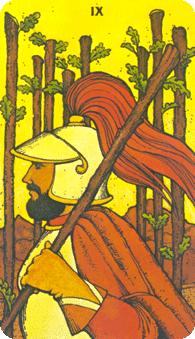Tarot and Fable:
9 of Wands: Considering the Nature of the Fence
(c) Cheryl Lynne Bradley 2003-7

"What makes us discontented with our condition is the absurdly exaggerated idea we have of the happiness of others."
- Proverb
'Never make a defense or apology before you are accused."
- Charles I
"Life is a great bundle of little things."
- Oliver Wendell Holmes
Most of us are familiar with the traditional imagery associated with the 9 of Wands. It is of a man with a bandaged head, holding a staff and deeply contemplating a wall or fence made of similar staffs. It would seem obvious that this is a man who has engaged in battles before and is prepared to fight again if necessary. Perhaps e he is really just standing looking at a past he can no longer see, except in his memories, with his back towards the future. It also makes us wonder about the nature of the wall.
Walls and fences are often built for privacy, to block a bad view, to reduce noise, to defend against unwelcome intrusion or invasion, to establish a border or a boundary, or as a means of confinement and setting limitations and standards. Such are the nature of physical walls but, if we think about, such are the nature of our emotional walls as well. We build walls to be self-protective, to prevent emotional risk, to hide our true selves, to hide from the past and the future, to preserve personal space and establish personal boundaries. All too often and all too easily, these walls become walls of confinement.
We have to remember that these walls have been carefully constructed over the course of our lifetime and are made up of our hopes, fears, pains, unreleased anger, unrequited love, emotional bondage, ego blockage and shattered trust - the posthole diggers of life so to speak. These walls can divide us from other people or keep us trapped in places where we really don't want to be. I have always thought that we look for people who mirror our pain, but I also think we look for people with the same walls. The source or purpose of the wall is not so much the issue. We have to find a way to remove or, at least, move the wall that prevents us moving forward or keeps us here defending the same position.
The following is a story which, for me, is the essence of the 9 of Wands.
A lion was captured and placed into captivity in a concentration camp. He was surprised to find other lions who had been there for years, some had even been born into captivity in the camp. He caught on to the social structure of the lions in the camp very quickly. They had banded together into various groups.
One group was very social and spent their time socializing. Another was into show business and performing and kept themselves busy entertaining others. A third group was cultural in its nature and their purpose was to preserve traditons, customs and the history of the times when lions roamed free. Other groups were religious, when they gathered they sang uplifting songs about a time in the future when there would be no fences in the jungle. Some of these groups attracted people who were creative and artistic. Other groups attracted revolutionaries and they gathered to plot against their captors or against other groups with revolutionary aims. Occasionally a war would break out and one group would wipe out another or the guards would be killed and replaced by a new set of guards.
The newcomer also observed one lion, often near the fence, who always seemed to be in deep contemplation. He was a loner who kept to himself, joined no group and avoided associating with the others as much as possible. He commanded the admiration and the hostility of everyone, for his presence created fear and self-doubt among the others.
He told the newcomer "Join no group. These poor fools are busy with everything except what is essential." "And what do you think is most essential?" asked the newcomer. "Studying the nature of the fence."
When you draw the 9 of Wands, remember to consider the nature of the fence.......

















